“What should I charge?”
At some point, every nutrition coach asks that question.
You could be just starting out and have no idea what’s fair. Maybe you have years of experience but wonder if your rates should be higher. Or perhaps you’ve heard what competitors charge and think, “Why not me?”
Trouble is, it’s hard to get a satisfying answer.
Even if you ask a coaching group on social media, the rates will often vary wildly among coaches, leaving you forever waffling between guilt (“Am I overcharging?”) and resentment (“I’m not getting paid enough!”).
How can you ever know the right amount for your services?
Through the power of data, thank you very much.
We asked more than 1,000 nutrition coaches: What do you charge?
But we didn’t stop there: We also inquired about their coaching practice, experience, client base, certifications, and more—because, when you’re determining what to charge, it all matters.
Then we ran a statistical analysis to see how each of these factors related to one another. End result: a report that showcases real income data from real coaches, along with the most relevant, practical takeaways for maximizing what you make.
In this article, you’ll discover:
- What most nutrition coaches typically charge per hour
- How to increase your hourly rate—with confidence
- The secret sauce behind the top-tier rates of “super earners”
- Your roadmap to price setting: What to charge today, and how to set yourself up to charge more in the future
Let’s dive in.
++++
What do most nutrition coaches charge?
According to our survey, the median hourly rate for nutrition coaching is $65 per hour. Just in case it’s been a while since you took a math class, here’s a quick refresher on the word median. It represents the midpoint. In other words, half the coaches we surveyed make less than $65 per hour. Half make more. (Note: All rates are in US dollars.)
Of the coaches who make more, we noticed two distinct groups.
- High earners who charge $10 to $15 an hour more than the median rate
- Super earners who are absolutely crushing it—charging double the median rate
If you’re currently charging below the median rate, don’t worry. We’re going to tell you how to go from a lower rate to a higher one.
It doesn’t take much of an hourly jump to make a big difference. For example, a $15 per hour raise can really add up fast. If you work 20 hours per week, that’s $300 more a week—and $15,600 more per year.
That’s a pretty sweet income bump.
But making good money isn’t just about how much you charge—it can also be about how many clients you have. (You already knew that, didn’t you?)
We found that people who charge more tend to have more clients. And vice versa. The super earners in our survey were more likely to have 20+ clients than people who charged less than the median rate.
Why? For one, when there’s a greater demand for a coach’s services, they can charge higher rates. But there’s also this: The secrets for charging higher rates (more experience and more education, for example) are the same secrets that help you net more clients.
So keep reading to find out how to go from a regular earner to a high earner—and then from a high earner to a super earner.
It Pays to Diversify
When we broke down rates by coaching type, we learned that in-person coaches who work with people face-to-face (say, at a gym, in an office, or in the client’s home) make roughly the same as online coaches who work digitally, through a website and email ($65/hour vs. $64.50/hour). People who do hybrid coaching (a mix of in-person and online), however, are charging significantly more: $75/hour.
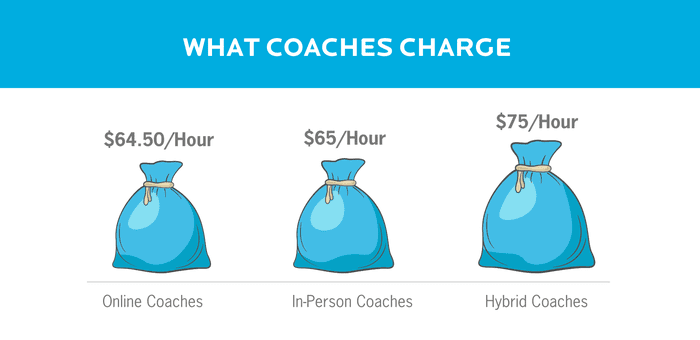
Five Secrets of High Earners
According to our research, high earners share several traits in common: experience, number of certifications, coaching hours, specialization, and confidence. Below, we explore each.
Secret #1: Set rates based on your experience.
Not surprisingly, more experienced coaches charge higher rates than less experienced coaches. They also have another income advantage: Coaches with more experience tend to have more clients.
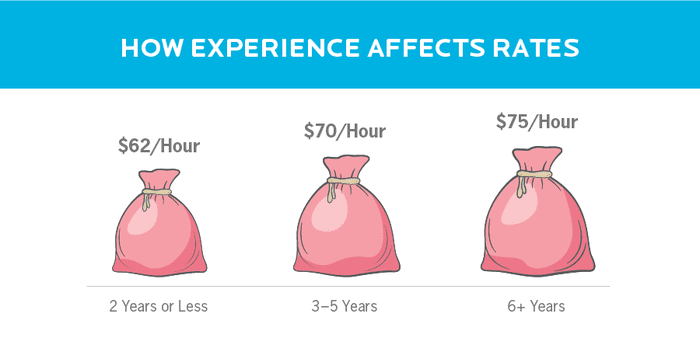
In our survey, most coaches with just one to four clients had two or fewer years of experience. Coaches with 20 or more clients, on the other hand, were much more likely to have more than three years experience, and more than a quarter of these booked-solid coaches had six or more years experience.
This makes sense because with more experience comes word-of-mouth marketing, says Mike Doehla, a Precision Nutrition Level 1 certified coach.
Doehla started coaching a few years ago with just a few clients, charging $120 for 12 weeks of his services. It didn’t cover the bills, which is why he kept his day job as a human resources manager.
As they reached their goals, however, those initial clients gushed about Doehla to just about anyone who would listen. More and more clients came Doehla’s way, so he inched up the rate for his 12-week package: $165, $175, $185…
Eventually, he founded Stronger U, a coaching company that charges $399 for 12-week programs, employs 69 coaches, and rakes in millions a year.
“The value comes from clients having a good experience and then telling everyone they know about us,” Doehla says. “99 percent of our customers come from word of mouth.”
Secret #2: Keep learning.
Education and certifications can give you confidence in your abilities, so you feel like your services are worth more (see secret #5). They also give clients the assurance they need to feel you’re worth your rate.
In our survey data, we found that coaches with one nutrition certification earned slightly more per hour than those with no certifications. (That’s no surprise, of course.)
We also found that coaches with a nutrition degree, two or more nutrition certifications, or one Precision Nutrition certification earned $12 more per hour than those with a single, non-Precision Nutrition certification.
In other words, the more certifications and education coaches have, the more coaches tend to earn.
But the programs you choose, and what you put into them, matter. Here’s why: The best certification and educational programs require you to invest more time and effort into mastering your craft.
If you’re just going through the motions and getting a certification for the piece of paper, you aren’t as likely to end up with that same level of confidence, which may prevent you from charging more. (Think of it as a mental barrier.) So, choose your certifications wisely, and embrace the learning process. It literally pays off.
In addition to a higher hourly rate, more certifications are also associated with more clients. In our survey, we saw that coaches with 20+ clients are also more likely to have two or more certifications.
To be clear: Clients don’t start lining up for your services on the day you earn a new certification. It’s more complex than that. Certifications help by giving you skills, knowledge, and confidence, which makes clients more likely to put their trust in you over someone else. Qualifications matter to clients. And what matters to clients needs to matter to you.
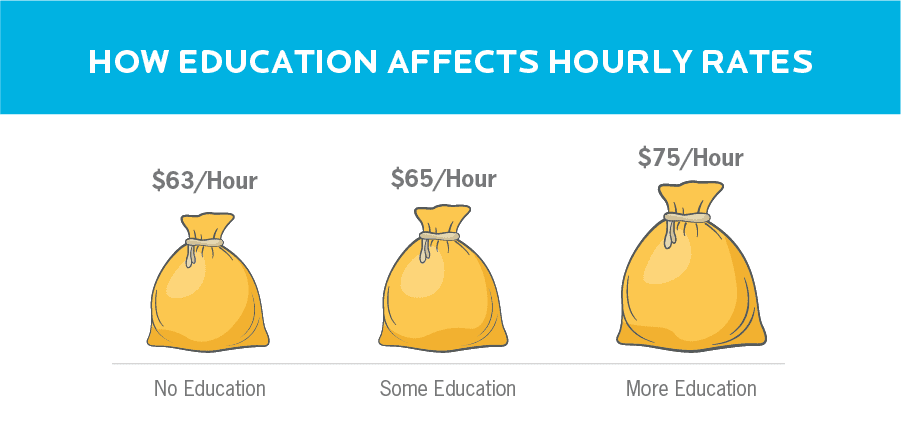
Secret #3: Make coaching your main hustle.
Sometimes it makes perfect sense to tack nutrition coaching onto an existing job, especially if you’re just starting out or thinking about a career change.
But if you really want to be a top-earner in this profession, consider dedicating yourself to nutrition coaching full-time. (Learn more: The real key to career success that almost no one is talking about.)
According to our survey, people who coach nutrition as a sole profession charge more than those who don’t, which begs the question: How do you know when it’s time to go all in?
For that answer, we sought Doehla’s advice once again. That’s because he spent 13 months working full-time in HR as he built his coaching business on the side. “Near the end, I was making more in a month from coaching than I was from my full-time job per year.”
To determine whether you’re ready to go all in, he says, “Figure out how much money you need to pay the bills and then double it.”
If you’re pulling that much, you’re definitely ready to coach full-time.
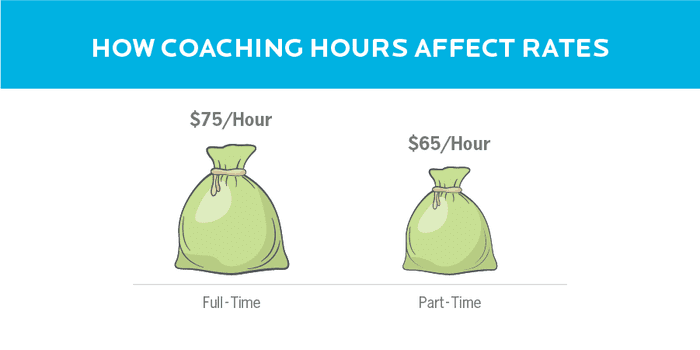
Secret #4: Consider specializing.
If you’re qualified to work with a special population, you might be able to charge more. For example, nutrition coaches who work with people with special health considerations told us they charge a median rate of $73 per hour. Coaches who work with seniors said they charge $70 per hour. That’s $5 to $7 above the median rate.
Now, your choice to specialize should come mainly from your passion to serve that specific population rather than your desire to pay your bills. Work with a niche group because you want to and are qualified to help them, and not just because you think it’s a ticket to higher rates.
And remember: Correlation doesn’t necessarily mean causation. Coaches who work with these populations may be able to charge more because of other factors (like years of experience, perhaps).
Finally, keep in mind that certain populations may also require you to charge less depending on what that population can afford. (For example, the median rate for coaches working with youth was just $60 per hour.)
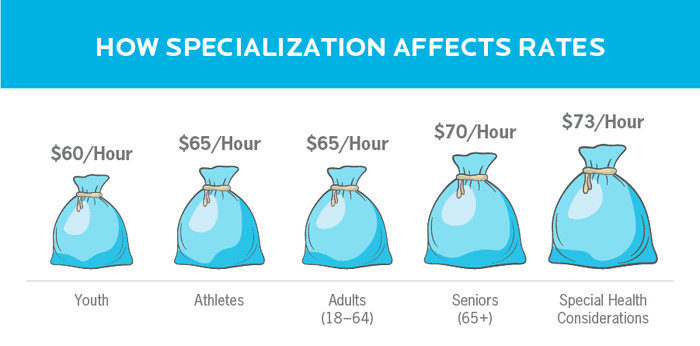
Secret #5: Believe in your worth.
Coaches who feel “completely confident” in their coaching skills say they charge $75 per hour, while coaches who are only “somewhat confident,” or “a little confident or less” charge just $60 per hour.
That’s a significant difference: $15 more per hour based on confidence.
So, how exactly do you build it?
The answer: Practice secrets #1 and #2.
With experience (secret #1), each successful encounter helps you to feel ready for the next. And certifications (secret #2) help you feel secure in your knowledge and skills.
But you need both.
Some people make the mistake of leaning too heavily into their education at the expense of gaining experience. They go to workshop after workshop and gain certification after certification as they wait and wait for the “okay, now I’m ready to coach” feeling to materialize, says Precision Nutrition Coach Kate Solovieva, who frequently fields questions from coaches about what to charge.
“New coaches want to feel 100% confident before they coach a single person. They want to feel like they know ‘enough.’ In other words, they want to wait until they aren’t scared anymore. Unfortunately, that moment never arrives. The best advice I can give to coaches starting out is to just start coaching,” Solovieva says.
You may wonder, “Can I really deliver? Am I good enough?” Waiting won’t answer that question, though. At a certain point, you need to do one and only one thing: Start coaching.
To reduce your anxiety, consider: Would you refuse treatment from a resident doctor? Would you ask to have your child moved from a classroom with a first-year teacher? If not, is it possible that potential clients have more confidence in you than you currently have in yourself?
Secrets of Super Earners
We just told you the secrets used by high earners. Now suppose you want to go even bigger and achieve a top-tier price point. How do you get there? Our data revealed some interesting insights.
In our survey, the top 10% of earners are charging more than $120 per hour. That’s nearly double the typical (median) rate.
What makes them special? Here’s what we noticed.
Super earners were more likely to…
- Have a nutrition degree or advanced certification such as Precision Nutrition Level 2 Master Class.
- Have more than two certifications.
- Have at least 3-5 years of experience.
- Work in a more specialized environment, such as a medical practice or in corporate wellness.
- Work with special populations.
- Offer a mix of in-person and online coaching as well as nutrition seminars.
- Work in nutrition coaching full-time.
Remember: super earners were statistically more likely to have those seven traits, but not every super earner had all seven. Just because you lack a nutrition degree, for example, doesn’t mean you can’t reach the super earner level. Rather than fixate on what you can’t do, focus on what you can.
If you can’t go back to school, for example, maybe you can set aside money and time each year to take new seminars or gather additional certifications. That’s what the most successful fit pros do. Take Alwyn Cosgrove, MS, co-founder of Results Fitness in California, and Michael Piercy, MS, owner of The LAB in New Jersey. They’ve taken courses from just about every health and fitness organization you can name.
Piercy, in fact, has earned a stunning 32 certifications (including Precision Nutrition Level 2). And you have to figure: It’s probably no coincidence he was also named the 2017 IDEA Global Personal Trainer of the Year, a TRX Master Instructor, and an ACE Master Trainer.
Okay, so what do I charge today?
Use the following chart, based on our data, to assess how much to charge based on where you’re at right now. And, if you want to increase your rate, this chart can also help you determine what you might need to do to get there.
(For all you fellow data nerds who want to know how we arrived at this: The following examples are based on what coaches are statistically more likely to have in common, according to our survey data.)
Once again, there are no hard and fast rules. Consider this a potential roadmap, not a rule book.
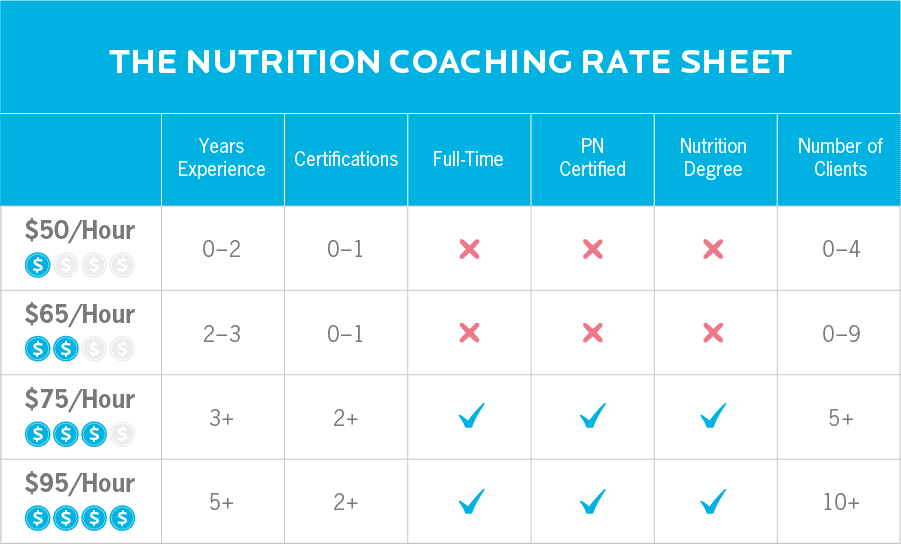
The above is based on what we’ve seen among our 1000+ survey respondents, so it provides a reasonable method to help you assess yourself and get started.
But please don’t let the categories constrain you. It’s up to you to define success for yourself.
For example, do you strive to be an expensive coach at the top of their game who always over delivers? Great! Go for it.
Or is your goal to simply go from “free” coach to “paid coach?” Awesome.
Perhaps your focus is on helping lower-income folks get healthier and you’re willing to work on a “pay what you can” model. Fantastic. More power to you.
Regardless of your goals, if you’re not where you want to be yet, that’s okay. Strive for progress, not perfection. Even the highest-earning coaches had to start somewhere.
Nutrition coaching is a highly customizable profession. You get to create it for yourself. Where you go from here is up to you.
What to do next…
Step 1: Practice your craft.
Get all the practice you can. Putting in the time is essential to gaining confidence, credibility, and ultimately a higher rate.
It’s also the secret to staying in the business long term. At Precision Nutrition, we’ve found that the people who get three to five clients right away are more likely to still be coaching a year later.
Go ahead and offer your services to family and friends, even if you don’t charge them initially. (You might think of it as your unpaid internship.) Be that person who generously gives incredibly helpful advice on social media. Eventually, as you help more and more people, you’ll grow into a more confident, more skilled coach—and the people you help will tell others about you.
Step 2: Give yourself a deadline.
Lots of coaches, especially those just starting out, don’t charge money for their services at first. They got into this line of work because they love nutrition, they love working out, and they just want to help people.
But eventually, you need to pay the electricity bill and feed the dog.
If you’re not charging for your services, ask yourself: “At what point will I start charging, and how will I know when I’m there?”
For example, perhaps you’ll start charging after a certain date or after coaching a certain number of people.
But whatever you choose, make sure you clearly define it. Otherwise, “the danger is that the bar is always moving,” says Solovieva.
“Many coaches believe they must be at a certain level before asking for money. They tell themselves, ‘I can’t charge people until I graduate from my cert, until I know enough, until I feel like I can answer any question, until I’ve arrived’, and so on,” she says.
It’s way too easy for “until” to populate your thought process continually.
At a certain point, in order to transition to a bonafide coach who gets paid for your services, you must set a price.
Sure, that leap can feel intimidating, or even scary, but waiting a little longer probably won’t help. “The truth is, you’ll always be afraid,” says Solovieva.
So pick a date and stick to it.
Step 3: Set your rate and feel confident about it.
When new coaches tell Kate Solovieva that they have “absolutely no idea” what to charge, she challenges that belief by taking them through an experiment.
Kate Solovieva: Okay, so how do you feel about charging $1/hour?
New Coach: Giggles.
Kate Solovieva: You’re giggling. Why?
New Coach: Because that’s way too low.
Kate Solovieva: Okay, well, how about $1,000/hour?
New Coach: Woah. That’s way too high.
Kate Solovieva: Hmm. So, already you have some idea in terms of what is too low and what is too high. Awesome. Let’s keep going. How do you feel about $500/hour?
New Coach: Still too high.
Kate Solovieva: $20 an hour?
New Coach: Too low.
And the conversation goes on until they arrive at a range that feels right.
Try it. You’ll come away with a baseline minimum rate for your services, along with your ceiling (even if that top rate is aspirational at the moment). From that range, go with the lowest number, based on your experience and education, you feel you could comfortably charge, Solovieva recommends.
Step 4: Consider whether you want to charge by the hour or by the package (or both).
For beginner coaches, hourly rates offer a great starting point. But as you gain experience—and especially if you coach online—monthly or package rates work better. Here’s why: Coaching involves a lot of work that doesn’t fit neatly into an hourly structure.
For example, let’s say a client texts you a picture of a brand of protein powder and asks for your opinion. You text back and forth for a few minutes. If you only charge by the hour, how do you invoice for those few minutes? And is it even worth your time to send an invoice for a few dollars?
Monthly or package rates can bake in those short interactions. They also simplify billing.
So how do you translate the median hourly rates mentioned earlier into package and monthly rates?
Do the following:
Define your package length.
Many coaches choose 12 weeks because it provides just enough time for clients to see meaningful results.
Consider what you’ll offer.
How many consultations will you include? Will you provide added services such as nutritional evaluations, menu development, or written resources? Once you decide on the scope of your package, consider the number of hours involved. How long will it take to develop materials? Meet with each client? Keep track of client data?
Create a pricing range that seems fair for the work involved.
Use Solovieva’s thought experiment from step 3. Does $1 for 12 weeks sound right? (Of course not!) How about $1000 a month?
Okay, let’s try $25 for 12 weeks? $750?
Keep upping the low number and reducing the high number until you have a range that feels fair, both to you and to potential clients.
And keep in mind that your package rate may not, at first, break down into an hourly rate that truly pays the bills. As you gather more clients and lean on existing resources, your hourly rate will climb, Solovieva promises.
In the meantime, consider reducing how much you offer (perhaps two monthly consultations rather than four) rather than boosting your rate, especially if you’re just starting out, says Solovieva. That way, you’ll keep your monthly rate low enough to attract new clients as you gain experience.
To learn more, read: 7 proven and profitable models for adding nutrition coaching to a health and fitness business.
Step 5: As you gain education and experience, raise your rates.
It can be awkward to raise your rates when you have existing clients who are used to paying a certain amount. Some coaches even worry it’s a betrayal.
But coaching is a business like any other, and it’s perfectly reasonable to increase your profits over time.
A good rule of thumb: Bump up your prices by 3 percent once a year to cover inflation, plus additional increases to reflect new training or services.
And don’t worry. “When you have social proof that what you do works, you can raise prices,” says Doehla. “You’ll earn the confidence to keep going higher by seeing that people still purchase what you’re selling each time you increase your rate.”
Overall, most coaches find that their clients actually applaud small fee adjustments. If you’re doing a good job for them, then they’re in your corner as much as you’re in theirs. Just give them plenty of notice (four to six weeks is enough), and let them know in writing through your newsletter or a handout when price increases are coming.
Make sure to tell them about any courses you’ve taken, testimonials and proven results you’ve gathered, or new tools or equipment you’ve added, so they feel they’re getting better service than ever.
What’s next—for you?
So now you know how your rates compare to others—and, even more important, what to do to confidently nudge your rate upwards. Exactly how you put our results into practice will depend on where you are right now.
But our final piece of advice applies no matter whether you’re a super earner or you’ve yet to earn a dollar from coaching. It’s this: Never stop practicing, never stop learning, and never stop growing into the absolute best coach you can be. Keep doing those three things and higher rates will always follow.
(Download a PDF of this exclusive report.)
What if you could make a real difference in the lives of others—and never feel confused about nutrition again?
When it comes to better health and fitness, focusing on nutrition is the most important and effective step. But there’s a big problem: Most people don’t feel qualified to coach nutrition, especially in a way that leads to deep health and lasting change.
If you’re a coach, or you want to be…
You can help people build sustainable nutrition and lifestyle habits that will significantly improve their physical and mental health—while you make a great living doing what you love. We'll show you how.
If you’d like to learn more, consider the PN Level 1 Nutrition Coaching Certification. (You can enroll now at a big discount.)



Share